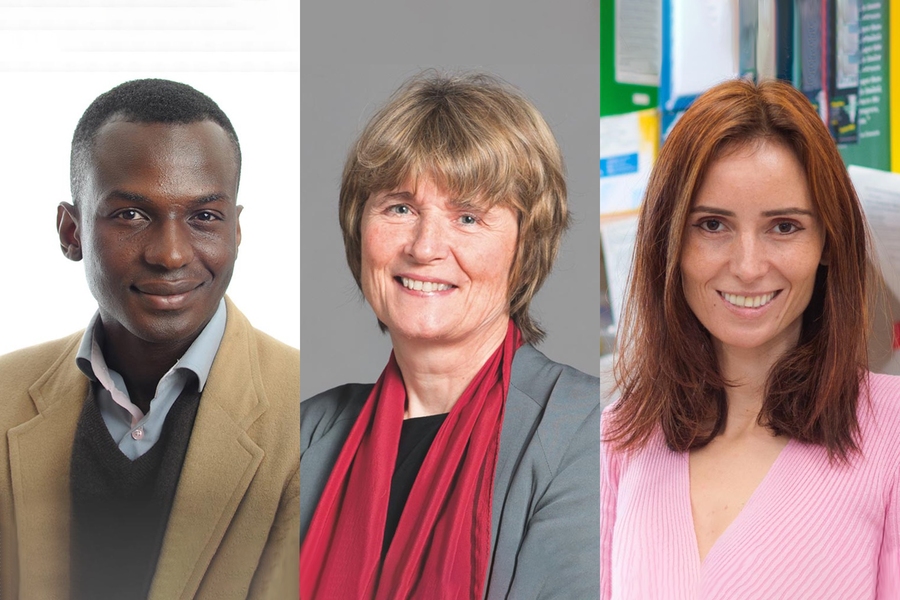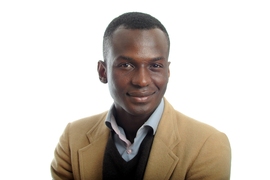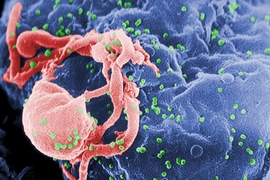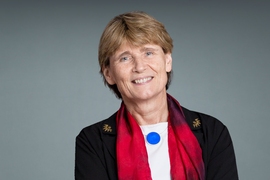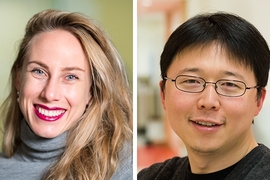Associate professor of physics and biology Ibrahim Cissé, professor of biology and Whitehead Institute Director Ruth Lehmann, and Andria and Paul Heafy Whitehead Fellow Silvi Rouskin have been awarded 2021 Vilcek Prizes. The Vilcek Foundation was established in 2000 by Jan and Marica Vilcek, who emigrated from the former Czechoslovakia. Their prizes honor the outstanding contributions of immigrants in the sciences and the arts. Prizewinners will be honored in an April ceremony.
“The 2021 awards celebrate the diversity of immigrant contributions to biomedical research, to filmmaking, and to society,” Vilcek Foundation President Rick Kinsel said in a press release. “In recognizing foreign-born scientists and dynamic leaders in the arts and in public service, we seek to expand the public dialogue about the intellectual value and artistic diversity that immigration provides the United States.”
Ibrahim Cissé
A faculty member in the departments of Physics and Biology, Ibrahim Cissé received the Vilcek Prize for Creative Promise in Biomedical Science for using super-resolution biological imaging to directly visualize the dynamic nature of gene expression in living cells.
Born in Niger, Cissé assumed he would be a lawyer like his father, but he soon became inspired by the science he saw in American films. His high school did not have a laboratory, so he completed high school two years early, enrolled in an English as a Second Language program at the University of North Carolina at Wilmington, and enrolled in Durham Technical Community College before transferring to North Carolina Central University, a historically Black college that was notable for its undergraduate science and mathematics research programs.
Following graduation, he spent a summer at Princeton University working in condensed matter physics. There, Cissé was confronted by physics professor Paul Chaikin with a question about elliptical geometry and particle density, using M&M’s candies. Cissé’s creative problem-solving enabled him and his fellow researchers to develop experiments for observing and quantifying their results, and they coauthored a paper that was published in Science magazine.
For graduate studies, he was at the University of Illinois at Urbana-Champaign, and earned a PhD under the supervision of single-molecule biophysicist Taekjip Ha, who was leading research in high-resolution, single-biomolecule imaging technology. Cissé’s interest in using physics to understand the physical processes in biology led him to a post-doctoral fellowship at École Normale Supérieure Paris. He showed that RNA polymerase II, a critical protein in gene expression, forms fleeting (“transient”) clusters with similar molecules in order to transcribe DNA into RNA. He joined the Howard Hughes Medical Institute’s Janelia Research Campus as a research specialist in the Transcription Imaging Consortium, before joining the MIT Department of Physics in 2014, and was recently granted tenure and a joint appointment in biology.
The Cissé Laboratory focuses on the development of high-resolution microscopy techniques to examine the behavior of single biomolecules in living cells, and his own research focuses on the process by which DNA gets decoded into RNA. His Time-Correlated Photoactivated Localization Microscopy (tcPALM) technique of imaging was able to peer inside living cells to study the dynamics of protein clusters. This discovery has led to breakthroughs in viewing the clustering and droplet-like behavior of RNA polymerase II during RNA transcription. In an interview with MIT News, he stated, “It’s becoming clearer that physics may be just as important as biology for understanding how cells work.”
Other national and international awards include the Young Fluorescence Investigator Award from the American Biophysical Society, the Pew Biomedical Scholars, and the National Institute of Health Director’s New Innovator Award. He is a Next Einstein Forum fellow and was listed in Science News’ Scientists to Watch.
Ruth Lehmann
Professor of biology and director of Whitehead Institute for Biomedical Research Ruth Lehmann received the Vilcek Prize in Biomedical Science. As a developmental and cell biologist, she investigates the biology of germ cells, which give rise to sperm and eggs.
The daughter of a teacher and an engineer, Lehmann was captivated by science from a young age. She grew up in Cologne, Germany, and majored in biology as an undergraduate at the University of Tübingen. Her Fulbright Fellowship in 1977 brought her to the University of Washington in Seattle, and served as the catalyst that spurred her career using fruit flies to understand germ cell biology. She went on to train with renowned fruit fly geneticists Gerold Schubiger and Jose Campos-Ortega, learning classical developmental biology and electron microscopy techniques. She then performed her doctoral research with future Nobel laureate Christiane Nüsslein-Volhard at the Max Planck Institute for Developmental Genetics. There, Lehmann probed the maternal genes that influence fruit fly embryo development — studies that ignited her fervor for germ cell research. Later, as a postdoc at the Medical Research Council Laboratory of Molecular Biology in Cambridge, England, she worked with Michael Wilcox and Peter Lawrence to pinpoint the molecules that control the fate of these vital cells.
Lehmann arrived at MIT in 1988, where she served as a professor and member of the Whitehead Institute for eight years. “Being an immigrant in the United States was exhilarating,” she says, “because of the openness to new ideas and the encouragement to take risks and be creative.”
She was recruited to the Skirball Institute at New York University (NYU), where she was appointed as the institute’s director, as well as the director of the Helen and Martin Kimmel Center for Stem Cell Biology, and chair of the Department of Cell Biology at NYU’s Langone Medical Center.
Lehmann returned to MIT this summer to launch the Lehmann Lab and become director of the Whitehead Institute in July.
Although she began her career focused on the formation and maintenance of germ cells, Lehmann has since revealed key insights into their migration — and more recently into mitochondrial inheritance. Her influential work regarding the development and behavior of these essential cells has also enriched related fields including stem cell biology, lipid biology, and DNA repair.
“It means so much to me to be recognized as an immigrant and a researcher,” says Lehmann. “In these days, immigrants don’t feel as welcomed as I did when I came to this country. For me, coming to the U.S. meant to be given a chance to live the dream of being a scientist. This allowed me to explore the fascinating biology of the germ line together with a group of incredibly talented trainees and staff, many of them immigrants themselves, and I share this wonderful recognition with them.”
Lehmann’s accolades include membership to the National Academy of Sciences, American Academy of Arts and Sciences, and European Molecular Biology Organization, as well as the Conklin Medal from the Society for Developmental Biology, the Porter Award from the American Society for Cell Biology, and the Lifetime Achievement Award from the German Society for Developmental Biology.
Silvi Rouskin
The Andria and Paul Heafy Whitehead Fellow at the Whitehead Institute, Silvi Rouskin received the Vilcek Prize for Creative Promise in Biomedical Science for developing methods to unravel the shapes of RNA molecules inside cells — aiding the potential development of RNA-based therapeutics.
The daughter of rock musicians in early-1980s communist Bulgaria, she grew up fascinated with the geometry of the flora and fauna around her. At 10, she started saving her lunch money to buy a miniature telescope. At 15 she knew that her best chances to study science would be in the United States, and so she joined a student exchange program in Idaho.
“I was not only allowed but encouraged to question my superiors,” she recalls. “I felt free to speak my mind, and often debated with my teachers.” Rouskin completed her GED and studied physics and biochemistry at the Florida Institute of Technology at 16.
As a staff research associate in the laboratory of Joseph DeRisi at the University of California at San Francisco, Rouskin first began studying RNA, using microarrays to detect and track viral infection. She opted to stay at UCSF to pursue her PhD in biochemistry and molecular biology.
She joined the Whitehead Institute in 2015, and established the Rouskin Lab to focus on the structure of RNA molecules, including viruses, and to determine how structure influences RNA processing and gene expression in HIV-1 and other viruses. Most recently, Rouskin uncovered the higher-order structure of the RNA genome of SARS-CoV2 — the virus that causes Covid-19 — in infected cells at high resolution.
“The goal of my own lab has been to perform basic RNA research with clear therapeutic applications and a particular focus on the vulnerabilities of RNA viruses,” says Rouskin. “I want my research to matter for medicine, and so I always approach my research with a cognizance of how my work can directly benefit people.”
Rouskin has also received the Harold M. Weintraub Graduate Student Award for outstanding achievements in biological sciences and the Burroughs Wellcome Fund Career Award at the Scientific Interface.
